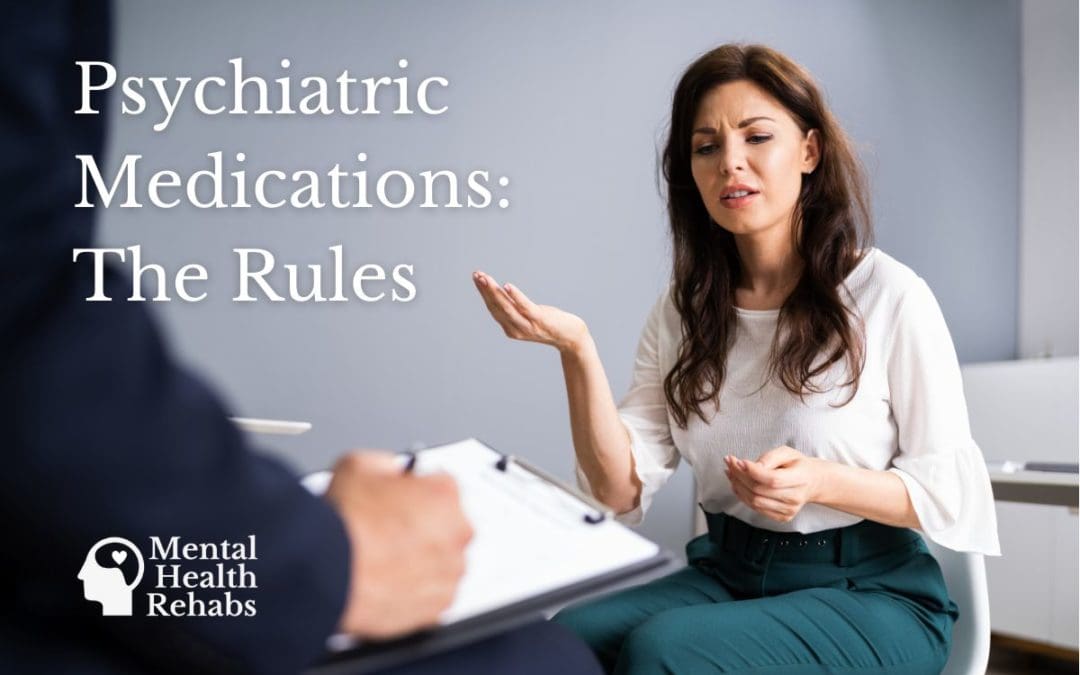Psychiatric medications, also sometimes referred to as psychotropic or psychotherapeutic medications, are used to help address the symptoms of mental illnesses like ADHD, anxiety disorder, bipolar disorder, depression, and schizophrenia. While they don’t cure mental illnesses, they can help make these sometimes severe psychiatric conditions much more manageable. Medications can help individuals struggling with psychiatric conditions to work, play, love, and socialize in ways they may not have been able to do otherwise.
However, as is the case with all prescription drugs, even highly effective and safe medicines carry some risks and side effects. To minimize the odds of an adverse reaction, it’s helpful to know how these drugs work and how they can mix with other things we might put in our bodies.
How Psychiatric Medications Work
Psychotropics work by influencing neurotransmitters, the chemical messengers of the brain that control what we do, how we do it, and how we feel about it. Mental illness is caused when there are imbalances in these important brain chemicals like when levels of a certain neurotransmitter are too high, low, or when a receptor is overactive or underactive. The brain has a very delicate chemical balance and even a minor imbalance can be majorly disruptive.
The specific mechanism of psychiatric medication (which neurotransmitter it affects and how) will depend on the kind of medication. This will also play a role in determining what to avoid when taking them.
Types of psychiatric drugs
There are five main types of drugs used to treat mental illnesses: antidepressants, anti-anxiety medications, antipsychotics, mood stabilizers, and stimulants.
Antidepressants
Antidepressants primarily affect the neurotransmitters serotonin, norepinephrine, and dopamine. There are several different types of drugs within this classification. SSRIs (selective serotonin reuptake inhibitors) are the most popular, followed by SNRIs (selective norepinephrine reuptake inhibitors). Older and less frequently used types of antidepressants are monoamine oxidase inhibitors (MAOIs), tricyclics, and tetracyclics.
Anti-anxiety
The most popular type of anti-anxiety drugs are benzodiazepines or ‘benzos’ for short. They replaced barbiturates as the drug of choice to influence GABA neurotransmitters and create a sedative effect.
Antipsychotics
Primarily used to treat schizophrenia, antipsychotics are used to treat any psychotic symptoms such as hallucinations, delusions, hearing voices, or paranoia. They are able to do so by blocking dopamine receptors.
Mood stabilizers
Mood stabilizers are a broad classification of medicine that rather than providing relief by targeting a single neurotransmitter, influences neurotransmitters, chemicals, and receipts in the brain for the overall effect of reducing abnormal brain activity.
Stimulants
Used to treat ADHD, prescription stimulants increase levels of dopamine and norepinephrine. Adderall is known to have serious interactions with old-school antidepressants called MAOIs.
Potential Causes of Drug Interactions
All medications have the potential to cause side effects. To minimize those risks when taking psychiatric medications, it’s recommended to avoid the following:
Alcohol
No surprise here. Alcohol and other drugs can cause drastic neurochemical changes in the brain. That’s why drinking is notorious for exacerbating the effects of other drugs and even mental illnesses.
Grapefruit
Your morning breakfast could put you in danger, both the fruit itself and its juice. This seemingly harmless citrus is known to cause drug interactions with over 80 agents. The main reason is that grapefruit possesses a compound that prevents an enzyme from being able to break down the medication, which could lead to dangerous chemical build-ups. Grapefruit is known to be extremely hazardous for all types of psychiatric medications.
Marijuana
A common misconception is that marijuana is “harmless”, but it’s been shown to carry a high risk of causing psychotic symptoms, including psychosis. Even without this side effect, marijuana can exacerbate anxiety and depression. Plus, strains have continued to become more and more potent over the years and marijuana is stronger—and potentially more dangerous—than ever.
St. John’s wort
A popular herbal remedy that has been used for centuries. However, it’s bad news to mix with many of today’s modern medicines. The FDA issued a Public Health Advisory in 2000 stating that the herbal supplement was found to interfere with medications for depression, seizure, heart disease, cancer, organ transplant rejection, oral contraceptives, birth control, blood thinners, and more.
When combined with drugs that increase serotonin such as antidepressants or migraine medications, it causes a dangerous buildup of serotonin in the body called serotonin toxicity.
Tyramine
A naturally occurring compound found in aged cheese, meats, and beer, tyramine can cause dangerous increases in blood pressure when combined with MAOIs, the older type of antidepressant medication.
Valerian root
Another herbal remedy, valerian root increases the sedative effects of other substances including alcohol, antidepressants, and anti-seizure medications. Chamomile, the popular base of a calming tea, also can enhance sedative effects when combined with medications, though not psychiatric ones.
To minimize your risk of incurring adverse side effects while taking psychiatric medications, find a mental health professional today who can help guide you to safer drug usage.

